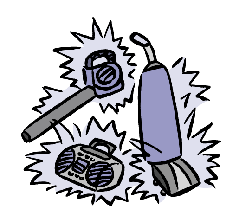
Preparing the annual budget and overseeing a community association's finances are perhaps the most important responsibilities of the association's board members.
It is a primary business duty of a community association to maintain and preserve market values of both the residential and common area property. To do so properly, directors must develop funding plans for future repair or replacement of major common-area components, such as swimming pools, decks, asphalt surfaces, concrete areas, fencing, monument signs, and much more. Using annual operating budgets and reserve budgets assist in reflecting the plans and goals of the association as well as in setting the level and quality of service for the community association's activities in the months and years ahead.
Community associations have several funding options, including periodic assessments over the life of the assets, special assessments at the time of the actual replacement, borrowing funds when needed, a combination of the above, or the most common practice of setting aside funds in a special category commonly called reserve funds, replacement reserves, replacement funds, or simply, reserves.
Why Reserve Funds Are Necessary
Owners are sometimes reluctant to contribute to reserve funds because they feel that these surplus funds are an added cost of living. These same owners often forget that the overall appearance of their community translates directly into its property value, which has been documented as the leading factor in members' satisfaction with their community. Additionally, one must remember that lenders look for signs of financial health when reviewing mortgage applications. Communities with inadequate reserve funds may find themselves at risk for mortgage denials. Equipment and major components must be replaced, whether the expense is planned or not. Today's boards of directors must educate their membership in understanding why property owners should invest in reserves now, even though the money seemingly might only benefit future owners. Reasons to be shared with the members for creating and adequately maintaining a reserve fund should be: (1) Fulfillment of legal, fiduciary and professional requirements (2) Requirements of the secondary mortgage market as dictated by Fannie Mae, FHA, VA and Freddie Mac (3) Deterioration/Depreciation of common assets from which current owners have benefited (4) It minimizes the need for unforeseen special assessments, especially for those on fixed incomes, (5) A replacement fund or reserve enhances resale values, and (6) Accounting standards require proper attention be paid to the reserve/replacement fund, given the depreciable nature of certain assets over time.
Before establishing a reserve/replacement fund, the community association should discuss its financial needs with its professional manager, CPA, engineer, or other trusted advisor. Community association reserve funds account for nearly $5 billion U.S. dollars today. With so many reserve advisors available, association leaders often encounter difficulties in selecting the best one for their association. Due to the technical details involved, the community association should hire a qualified, experienced person to prepare its reserve study and any of the above professionals can typically point the association in the right direction. Additionally, a board may begin by talking to other association boards, learning about industry trends, and checking references.
Two Types of Reserve Analysis: Physical and Financial:
- Physical Analysis During the physical analysis, a reserve specialist typically performs a site inspection evaluating information about the physical status of the association and the repair/replacement cost of the major common area components. The reserve specialist conducts an inventory of the association's assets, renders a condition assessment, and completes a life expectancy evaluation. The component inventory should be relatively stable from year to year.
- Financial Analysis The financial analysis is made up of a finding of the client's current reserve fund status (measured in cash or as a percent funded) and a recommendation for an appropriate reserve contribution rate.
Of course, standard operational expenses continue to occur annually and can be effectively budgeted each year. Such expenses should include all minor expenses which would not adversely affect an operating budget from one year to the next. Examples of operational expenses are:
- Utilities
- Services: landscaping, street sweeping
- Administrative: management fees, copies, and postage
- Repair Expenses: equipment repairs, minor concrete repairs, fence and gutter repairs
Types of Reserve Studies

There are three categories that describe the various types of reserve studies, from an exhaustive to minimal in reference to the level of service.
- Full Reserve Study is one in which the following study tasks are preformed: (1) Component inventory (2) Condition assessment based on visual observations (3) Life and valuation estimates (4) Fund status (5) Funding plan
- Update, with site visit/on-site review where all of the above noted study tasks are performed as an update to the previous study.
- Update with no site visit in which only the following tasks are performed: 1) Life and valuation estimates 2) Fund status 3) Funding plan
In establishing the component inventory, one must review the documents and statutory requirements to determine which components are to be included in the common elements. Once common elements are established, you then must review the maintenance contracts to determine the appropriateness of including all or portions of a component for proper funding. One should then review the budget for components such as fences and sidewalks, which are generally replaced in small, low-cost increments. Next, confirm that the component funded in the overall budget is not also funded in the reserve. Identify all mechanical equipment. Generally, moving parts should be included and reviewed for their longevity. Then determine if the component will be normally excluded for repairs or replacements of the association's assets which have an estimated useful life expectancy equal to or exceeding the estimated useful life of the community itself. Not all common-area components require on-going preventive maintenance and therefore may not be required to be on the reserve schedule.
Selecting a Funding Method
Securities, financial securities are critical. Selecting a Funding Method is the final step of the reserve planning process. Community associations typically set aside a separate section of the budget for the reserve. The study is normally prepared prior to the fiscal year end for use in the budget preparation process. There are four primary funding strategies, known as Full funding, Baseline funding, Threshold funding and Statutory funding.
- Full funding is to attain and maintain the reserves at or near 100 percent.
- Baseline funding is an approach to keep the reserve cash balance above zero at all times. This means that while each component may not be fully funded, the reserve balance should not drop below zero during the projected period.
- Threshold funding is based on the baseline funding concept, but allowing a minimum reserve cash balance as the threshold. It relies upon a predetermined dollar amount as the threshold.
- Statutory funding is based on local statutes which set aside a specific minimum amount of reserves as required by law.
Each community association has the task of devising a plan to provide income to a reserve fund to offset anticipated expenditures from that fund. No matter what funding method is used, the community association should always remember to review the fund balance over a period of time and or as it adds or deletes components that will affect the fund. Consequently, adjustments to the annual contribution rate should be made from time to time in order to assure adequate replacement funds are available when needed.
Reviewing the Reserve Study

A reasonable methodology in reviewing a reserve study for purposes of assuring informative content, both now and into the future, is to gather the following:
- A summary of the community association's number of units, physical description, and reserve fund financial condition.
- A projection of reserve starting balance, recommended reserve contributions, projected reserve expenses, and projected ending reserve fund balance for a minimum of 20 years.
- A tabular listing of the component inventory, component quality or identifying descriptions, useful life, remaining useful life, and current replacement cost.
- A description of methods and objectives utilized in computing the fund status and development of the funding plan.
- Sources utilized to obtain component repair or replacement cost estimates.
- A description of the level of service by which the reserve study was prepared.
- Fiscal year for which the reserve study is prepared.
Reserve Studies can be very complex and sometimes difficult to read. However, the board of directors should feel confident and knowledgeable with the study provided to them. They should have a clear and concise understanding of the components identified and analyzed for proper funding before they provide their membership with the report. Asking questions of the preparer should be a standard part of any review. As the saying goes, there are no dumb questions.
Summary for Membership
It is suggested that a summary of the reserve study be provided for general distribution. Such a summary should be as simple as possible for the board members to relay to the membership. The summary can be as basic as providing an Annual Expenditure Detail which generally provides the following summary:
- Lists the replacement year i.e. 2002, 2003, 2004 etc.
- Lists the repair/replacement required for that particular year i.e. wrought iron painting, and
- Provides the amount of reserve expenditures to be paid out in a specific year.
Careful planning for future repairs and replacements allows the membership to know that the board of directors is taking its fiduciary responsibility seriously and that the directors are truly being good stewards of the association's money. There are professionals readily available to assist community associations in protecting the physical and fiscal needs of their communities for all the years ahead. That said, such safeguards always commence with the proper development and maintenance of sufficient reserves.
Related Articles Concerning Reserve Studies
- How To Collect Delinquent HOA Dues And Fees
- What is an HOA or Homeowner Association?
- Why Have a Professional Reserve Study?
- The Great Debate: Should We Reserve for Siding?
- The Importance of Reserve Planning and Funding
- Reserve Now Or Pay Later
- The Case For Reserves: A Cautionary Tale
- Budget Preparation Tips
- HOA Website Can Save Money And Increase Communication
- How Neighborhood Assoc Websites Can Increase Participation
- A Condo Association Website Can Facilitate Communication
 Print
Print Email
Email







